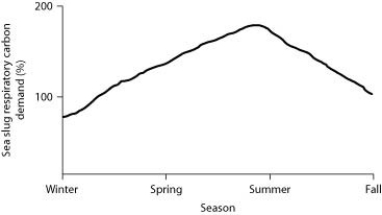Use the information and figure to answer the following question.
The sea slug Pteraeolidia ianthina can harbor living dinoflagellates (photosynthetic protists) in its skin. These endosymbiotic dinoflagellates reproduce quickly enough to maintain their populations. Low populations do not affect the sea slugs very much, but high populations (> 5 × 10⁵ cells/mg of sea slug protein) can promote sea slug survival.
Percent of sea slug respiratory carbon demand provided by indwelling dinoflagellates.
If the dinoflagellate-containing sea slug P. ianthina preys on coral animals, then it would be most surprising to find that ________.
Definitions:
Dendrites
Root-like parts of neurons that receive impulses from other neurons.
Neurons
The basic working units of the brain, specialized cells that transmit information through electrical and chemical signals.
Axon terminals
The endings of axons, responsible for transmitting signals through neurotransmitters to other neurons or muscles.
Neurotransmitters
Chemical messengers that transmit signals across a chemical synapse, from one neuron (nerve cell) to another target neuron, muscle cell, or gland cell.
Q8: Which of the following approaches would be
Q11: Two groups of tomatoes were grown under
Q13: A mineral deficiency is likely to affect
Q40: Whiteflies are common pest insects found on
Q52: Imagine that you are a research chemist
Q54: Which of the following are important components
Q58: The following question is based on the
Q71: Which clade does not include humans?<br>A) synapsids<br>B)
Q72: Use the following information to answer the
Q75: Which of the following is an accurate